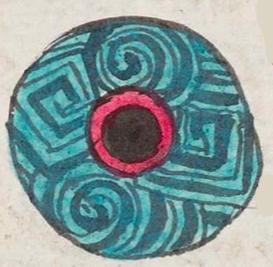Atezcahuacan (Mdz12r)
This compound glyph for the place name Atezcahuacan includes two principal elements. One is the glyph for mirror (tezcatl), which is located in the middle of a pool of water (atezcatl). The water is swirling with both rounded whirlpools and rectangular ("stepped fret") ones, including some thick black lines. The rectangular swirls may refer to the xicalcoliuhqui design. The mirror is a concentric circle, red around the edge and black in the middle. The possessor (-hua-) is not shown visually, just as the locative suffix (-can) is not shown visually.
Stephanie Wood
If we choose to take the tezcatl literally, we could say the place name is "At the Mirror Pond," but it could also be a reinforcing phonetic factor that was meant to tell us that this water was not just any body of water but an atezcatl, pool or pond. The Codex Mendoza glyph collection includes two different renderings of Atezcahuacan. See below, right.
Stephanie Wood
atezcahuacan. puo
Atezcahuacan, pueblo
Stephanie Wood
c. 1541, or by 1553 at the latest
Stephanie Wood
pools, ponds, puddles, water, mirror, reflection, piscinas, estanques, charcos, agua, espejo, reflexión, nombres de lugares

a(tl), water, https://nahuatl.wired-humanities.org/content/atl
tezca(tl), mirror, https://nahuatl.wired-humanities.org/content/tezcatl
atezca(tl), pool or puddle, https://nahuatl.wired-humanities.org/content/atezcatl
-hua- (possession, containment), https://nahuatl.wired-humanities.org/content/hua
-can (locative suffix), https://nahuatl.wired-humanities.org/content/can-2
xicalcoliuhqui, stepped fret coil, https://nahuatl.wired-humanities.org/content/xicalcoliuhqui
"Place That Has a Pool of Water" (having no disagreement with the Berdan and Anawalt interpretation) [Frances Karttunen, unpublished manuscript, used here with her permission.]
"Where There are Lagoons" (Gordon Whittaker, forthcoming essay, 2022); "Place That Has a Pool of Water" (Berdan and Anawalt, 1992, vol. 1, p. 172)
"Donde Hay Lagunas"
Gordon Whittaker
Codex Mendoza, folio 12 recto, https://digital.bodleian.ox.ac.uk/objects/2fea788e-2aa2-4f08-b6d9-648c00..., image 34 of 188.
The Bodleian Libraries, University of Oxford, hold the original manuscript, the MS. Arch. Selden. A. 1. This image is published here under the UK Creative Commons, “Attribution-NonCommercial-ShareAlike 3.0 License” (CC-BY-NC-SA 3.0).



